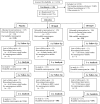Various doses of soy isoflavones do not modify mammographic density in postmenopausal women
- PMID: 19321587
- PMCID: PMC2714394
- DOI: 10.3945/jn.108.102913
Various doses of soy isoflavones do not modify mammographic density in postmenopausal women
Abstract
Soy isoflavones have functional similarity to human estrogens and may protect against breast cancer as a result of their antiestrogenic activity or increase risk as a result of their estrogen-like properties. We examined the relation between isoflavone supplementation and mammographic density, a strong marker for breast cancer risk, among postmenopausal women. The Osteoporosis Prevention Using Soy (OPUS) study, a multi-site, randomized, double-blinded, and placebo-controlled trial assigned 406 postmenopausal women to 80 or 120 mg/d of isoflavones each or a placebo for 2 y. Percent densities were assessed in digitized mammograms using a computer-assisted method. The mammogram reader did not know the treatment status and the time of mammograms. We applied mixed models to compare breast density by treatment while considering the repeated measures. The mammographic density analysis included 358 women, 88.2% of the OPUS participants; 303 had a complete set of 3 mammograms, 49 had 2, and 6 had only 1 mammogram. At baseline, the groups were similar in age, BMI, and percent density, but mean breast density differed by study site (P = 0.02). A model with all mammograms did not show a treatment effect on any mammographic measure, but the change over time was significant; breast density decreased by 1.6%/y across groups (P < 0.001). Stratification by age and BMI did not reveal any effects in subgroups. In this randomized 2-y trial, isoflavone supplements did not modify breast density in postmenopausal women. These findings offer reassurance that isoflavones do not act like hormone replacement medication on breast density.
Figures
References
-
- Boyd NF, Lockwood GA, Martin LJ, Knight JA, Byng JW, Yaffe MJ, Tritchler DL. Mammographic densities and breast cancer risk. Breast Dis. 1998;10:113–26. - PubMed
-
- Boyd NF, Rommens JM, Vogt K, Lee V, Hopper JL, Yaffe MJ, Paterson AD. Mammographic breast density as an intermediate phenotype for breast cancer. Lancet Oncol. 2005;6:798–808. - PubMed
-
- Maskarinec G, Pagano I, Lurie G, Kolonel LN. A longitudinal investigation of mammographic density: the multiethnic cohort. Cancer Epidemiol Biomarkers Prev. 2006;15:732–9. - PubMed
-
- Boyd NF, Greenberg C, Lockwood G, Little L, Martin L, Byng J, Yaffe M, Tritchler D. Effects at two years of a low-fat, high-carbohydrate diet on radiologic features of the breast: results from a randomized trial. J Natl Cancer Inst. 1997;89:488–96. - PubMed
-
- Boyd NF, Martin LJ, Stone J, Greenberg C, Minkin S, Yaffe MJ. Mammographic densities as a marker of human breast cancer risk and their use in chemoprevention. Curr Oncol Rep. 2001;3:314–21. - PubMed


